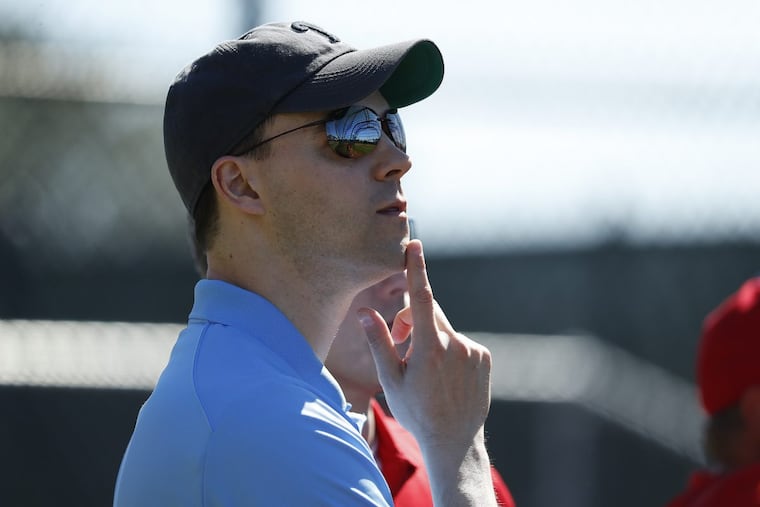As Phillies eye Bryce Harper and Manny Machado, a look back at when Matt Klentak signed Albert Pujols | Mike Sielski
Matt Klentak was just 31, and less than a month into his job as the Angels' assistant general manager, when his new team made a signing that shocked Major League Baseball.

Matt Klentak was just 31, less than a month into his job as the assistant general manager of the Los Angeles Angels of Anaheim, when his new team made a signing that shocked Major League Baseball, as much for the franchise that pulled it off as its scope and cost.
Klentak joined the Angels in November 2011. On Dec. 8, 2011, the Angels reached an agreement with Albert Pujols on a 10-year, $254-million contract. Pujols had been the St. Edward’s Crown of that offseason’s collection of free agents, just as Bryce Harper and Manny Machado are this offseason. Given that Klentak was still early in his career as a front-office executive when the Angels acquired Pujols, it’s useful to consider how that signing, its context, and its circumstances might be informing his thinking now that he’s the Phillies’ GM, now that he’s playing a waiting game with Harper, Machado, their agents, and the other franchises that might sign them.
Consideration No. 1: The perils of a 10-year contract
Pujols was 32 years old when he signed with the Angels. It’s easy enough to compare his age then to Harper’s and Machado’s now – they’re both 26 – and suggest that it wouldn’t be as risky for the Phillies to sign one of them to a similar deal. One mitigating factor was that Pujols was a better hitter than either Harper or Machado. So even if he did decline, his production might still validate the years and money.
It really hasn’t, though, and enough of those long-term, huge-money signings have turned out to be busts or burdens that teams are wary of them now. Alex Rodriguez with the Rangers in 2000, Pujols and the Angels in 2011, Robinson Cano with the Mariners in 2013, Giancarlo Stanton with the Marlins in 2014: Executives and owners regard these deals as cautionary tales, either because the player didn’t meet the expectations of the contract or because his team didn’t perform well despite its spending all that money on him.
Consideration No. 2: The National League’s absence of a designated hitter
One of the reasons that Pujols wanted to sign with the Angels, and that they were willing to give him 10 years, was the presumption that, as his career neared its end, he would no longer play in the field. Pujols had split time at first base, third base, and the outfield over his first 11 seasons in the majors, all in the National League with the Cardinals, but the opportunity to transition to DH promised to ease the wear and tear on his body.
Neither Harper, who has played center and right field, nor Machado, a third baseman/shortstop, would have that luxury with the Phillies – a fact that Klentak has to take into account when weighing how many years to offer each of them.
Consideration No. 3: Pujols’ representation
Pujols’ agent in 2011 was Dan Lozano, who is also Machado’s agent. So Klentak got a brief chance to observe and understand the way Lozano operates and negotiates. That familiarity could be helpful, because every owner and executive in Major League Baseball already knows the playbook for Harper’s agent, Scott Boras. Boras will wait and wait and wait, and everyone around baseball knows he will return to the bargaining table when he’s good and ready, and everyone around baseball knows he won’t be sped up in that process.
Consideration No. 4: The impact of an owner
Jerry DiPoto, the Angels’ GM in 2011, was the franchise’s point man for the Pujols negotiations, but make no mistake: It was owner Artie Moreno who stepped in and closed that deal, because for a contract of those dimensions, the owner almost always steps in and closes the deal. Tom Hicks did it for the Rangers with Rodriguez, for instance, and Nationals owner Ted Lerner did it when his team signed Max Scherzer (another Boras client) for seven years and $210 million in 2015. It’s why Boras’ strategy, generally, is to communicate with teams directly through their owners.
Now, would Phillies owner John Middleton, who said he was willing to spend “stupid money” this offseason, just call up Boras and/or Lozano, ask, OK, what’s it going to take?, and start scribbling in his checkbook? Maybe. But it’s now early February – spring training is two weeks away – and that hasn’t happened yet.
Consideration No. 5: The different standards for measuring a deal
At the time of the Pujols-Anaheim deal, such contracts were usually evaluated – by owners, general managers, agents, media members, and fans – in binary terms: Did you get the guy or not? Think back: When Cliff Lee, age 32, signed with the Phillies for five years and $120 million in December 2010, how many fans cared that he might be a shell of himself by the fourth year of that agreement?
Nowadays, the public and intra-MLB scrutiny of any contract is greater and more detailed. The standard isn’t, Did you get the guy or not? It’s Did you get a good deal or not? Klentak, Middleton, and the Phillies could sign Harper or Machado and still be criticized or deemed failures for the structure of the contract, and there isn’t a front office in baseball that isn’t cognizant of that truth.